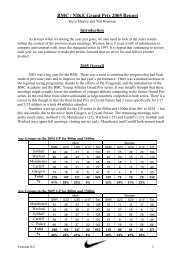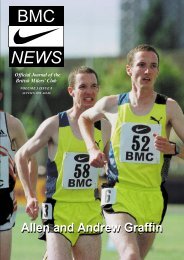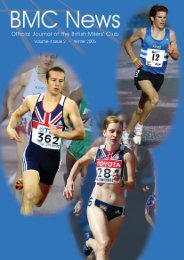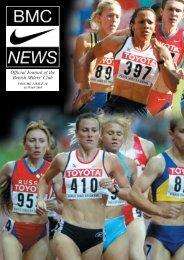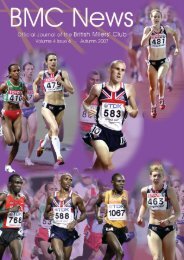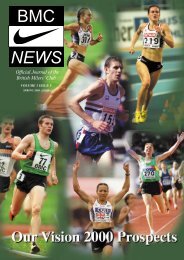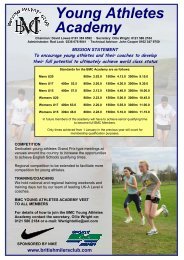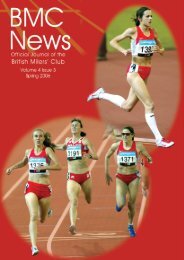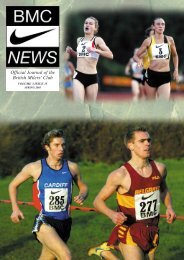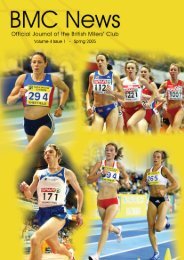BMC NEWS - British Milers Club
BMC NEWS - British Milers Club
BMC NEWS - British Milers Club
Create successful ePaper yourself
Turn your PDF publications into a flip-book with our unique Google optimized e-Paper software.
Eugene’s Favourite Son<br />
by Will Cockerell<br />
Last May saw the 25th anniversary of<br />
the tragic death in a car crash of U.S.<br />
track runner Steve Prefontaine.<br />
Despite two feature films about his life in the<br />
late Nineties he remains relatively little<br />
known in Britain. But in these somewhat<br />
quiet years for <strong>British</strong> Middle-distance<br />
running it’s worth reinvestigating the career<br />
of an athlete who’s famous motto was: "A lot<br />
of people run to see who’s the fastest. I run<br />
to see who has the most guts."<br />
Last September’s heroic Olympic run by<br />
Paula Radcliffe will have brought<br />
Prefontaine memories flooding back for<br />
"Pre" fans. Radcliffe could well have<br />
medalled if she had run her race a little<br />
differently, and dictated a somewhat less<br />
violent pace. But she didn’t want to medal -<br />
she wanted to win. And if that meant taking<br />
an enormous gamble then so be it. At the<br />
Munich Olympics 28 years earlier, a certain<br />
brash, young American had tried the same<br />
"blood, sweat and tears" approach as<br />
Radcliffe’s, only to suffer an identical<br />
agonizing fate.<br />
Alberto Salazar, one of the all time greats<br />
of U.S. distance running has this to say about<br />
Prefontaine:<br />
"Pre inspired a whole generation of<br />
American distance runners to excel. He<br />
made running cool. He created the whole<br />
idea of training really hard and going for it.<br />
Runners setting goals for themselves,<br />
wanting to go all out and be really tough.<br />
That was his example."<br />
The Early Days<br />
Notes Prefontaine biographer, Tom<br />
Jordan: "to attain and maintain the fitness of<br />
a world-class runner, three factors must be<br />
present: physical ability, mental tenacity, and<br />
plenty of hard work."<br />
And, even from the early days of training<br />
in his home town of Coos Bay, Oregon, Pre<br />
had a dedication that set him apart. Recalls<br />
teammate Lars Kaupang of Norway: "He<br />
seemed to be able to go out on the track and<br />
do three-quarter miles, half-miles, miles, all<br />
by himself, and he was able to push himself<br />
to a limit that nobody else could."<br />
Interestingly, Pre admits that he by no<br />
means loved all his training:<br />
"It really gets grim until the competition<br />
begins. You have to wonder at times what<br />
you’re doing out there. Over the years, I’ve<br />
given myself a thousand reasons to keep<br />
running, but it always comes back to where it<br />
started. It comes down to self-satisfaction<br />
and a sense of achievement."<br />
There were several unusual features to the<br />
Prefontaine training programme. No matter<br />
what time he went to bed the night before, he<br />
was up the next morning at 6:00am and out<br />
the door at a six-minute-mile pace. He<br />
believed that any work done at a pace slower<br />
than that would not do him any good.<br />
It seems that he was so focussed on his<br />
runs that he really didn’t notice where he was<br />
running often choosing a route by railroad<br />
tracks, or by industry. Teammate Terry<br />
Williams states:<br />
"Like one day, it was raining kind of hard.<br />
We have this cemetery right across from the<br />
gymnasium. He started out there - I thought<br />
we were going for a road run - but he just ran<br />
there. I followed him for 40 minutes in that<br />
cemetery, and he never did one full loop as<br />
we wandered around."<br />
The Track<br />
Oregon coach Bill Dellinger speaks of<br />
what Pre’s greatest talent might have been,<br />
and he puts it down as consistency. Wheras<br />
most people would be able to do a few of<br />
Pre’s brutal workouts before breaking down<br />
with illness or injury, Dellinger points out,<br />
"he went through four years of college<br />
without ever missing a workout because of a<br />
cold or illness. Four years of never missing<br />
any meets".<br />
One workout followed as such: 2 x 1 mile<br />
with a 5 min recovery in 4:12. One day, with<br />
his team-mates giving their moral support,<br />
Pre put the first one together in 4:08. His<br />
pals then asked him how he expected to do<br />
the second with slowing. That was all he<br />
needed, as he returned a 4:02.8.<br />
It was the same courage that Steve brought<br />
to racing. Of the 153 outdoor track races in<br />
which he competed, he recorded just one<br />
DNF, and won 120 of those outings.<br />
The Munich Olympics<br />
Going into the Munich Olympics of 1972,<br />
Pre had one or two things to think about. The<br />
first was his age. Nobody under 25 had ever<br />
won the Olympic ‘five’. Also the 5000<br />
meters was delayed after the slaying of the<br />
12 Israeli athletes by elements of the<br />
Palestine Liberation Organization. Not only<br />
was Pre extremely shaken and upset by the<br />
incident - which stole all of the glamour of<br />
the Games for him - but the time change<br />
meant that all those who competed in the<br />
10,000 meters would get an extra days rest.<br />
As the 13 finalists approached the line, in<br />
front of over 80,000 expectant spectators,<br />
perhaps the strongest field of 5000-meter<br />
runners in Olympic history was on view.<br />
Two in particular stood out. The daunting<br />
presence of Lasse Viren, who had broken the<br />
10,000 meters world records days earlier,<br />
and Mohamed Gammoudi who had an even<br />
more spanking CV - which is actually worth<br />
examining since it gives a clue to the events<br />
in the final stages of the race.<br />
A 33-year-old soldier, Gammoudi had 8<br />
years earlier competed in the electrifying<br />
Olympic 10,000 final in Tokyo. There he<br />
had edged out hot favourite Ron Clarke<br />
before just losing the gold to the amazing<br />
kick of American Billy Mills. Four years<br />
later in Mexico, he was 3rd in the 10,000,<br />
and with great grit and determination beat<br />
Kenyan legend Kip Keino by two-tenths of a<br />
second to win the 5000. So if being<br />
defending champion was one reason<br />
Gammoudi would be a major threat, the<br />
other was the 10,000 days earlier in the<br />
Munich Games. Half-way through the final<br />
Viren stumbled and fell, taking Gammoudi<br />
with him. But wheras Viren recovered to<br />
take the gold, Gammoudi was too stunned by<br />
the fall and had to drop out of the race. He<br />
wasn’t smiling.<br />
Steve Prefontaine records:<br />
1500: 3:38.1<br />
Mile: 3:54.6<br />
3000: 7:42.6<br />
5000: 13:21.9<br />
10,000: 27:43.6<br />
24<br />
<strong>BMC</strong> News : Spring 2001



